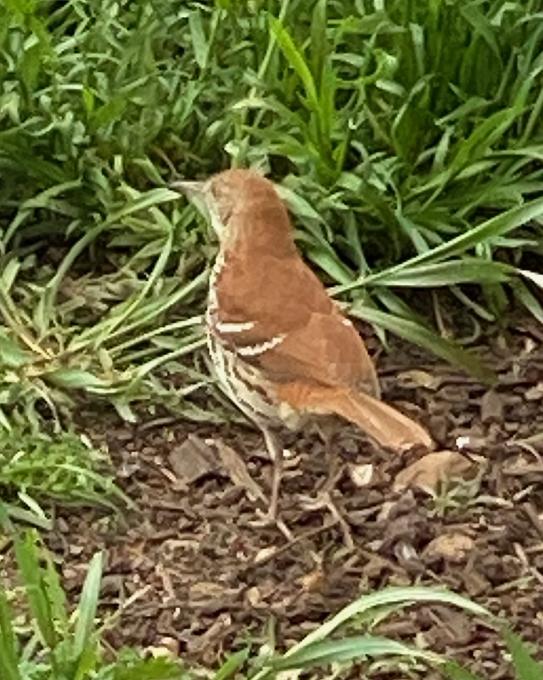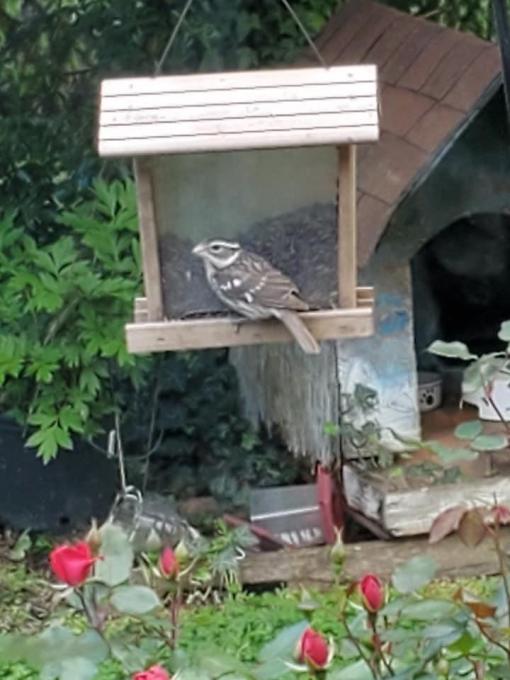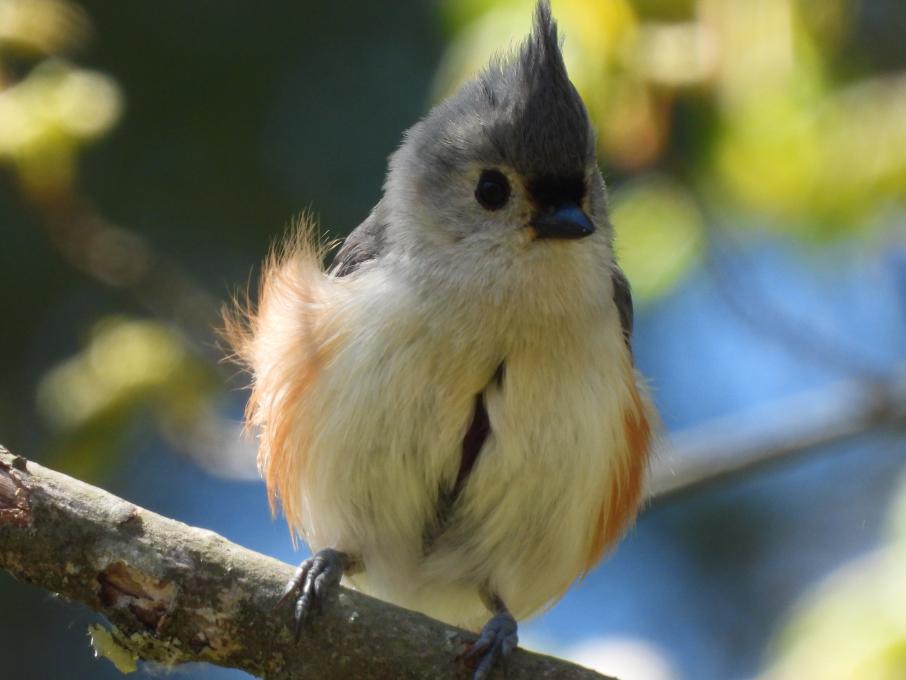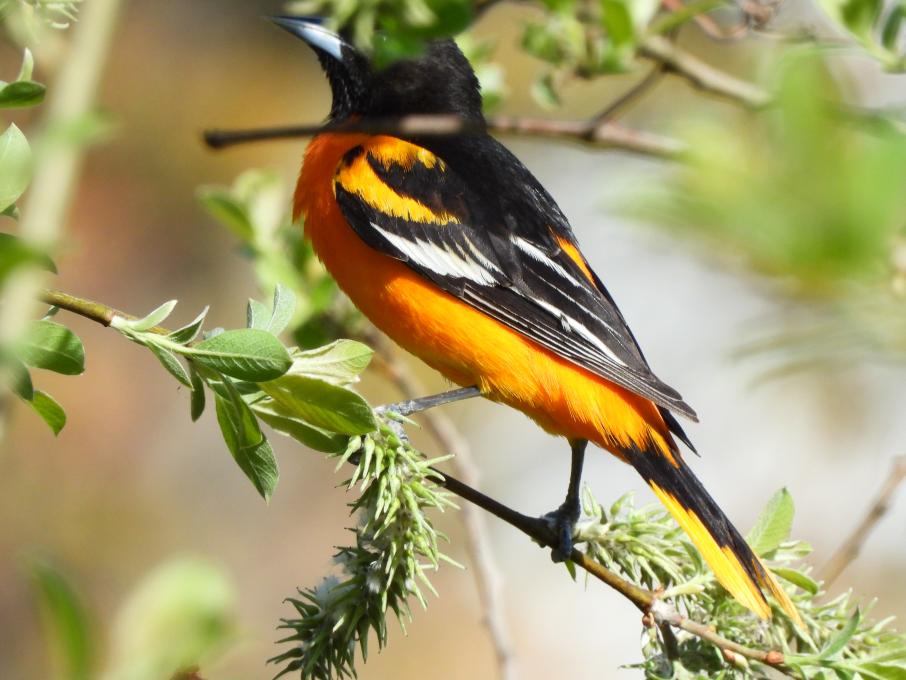The Cornell Lab Bird Academy › Discussion Groups › Joy of Birdwatching › Activities: Local Bird Exploration
-
Activity 1 - Cornell Feeder Watch Cam The first birds looked like Grackles to me. Mostly black with a iridescent bluish head and neck. Black bill and legs. But then some arrived with similar colors, dark head, speckles on side and top of tail, and some grayish streaks. And yellow bill and legs. I heard a metallic sound and also a raspy sound. They were both robin size or larger. Using Merlin, the yellow beak helped identify some of them as a European Starling. The ones with the bluest heads and black bills and legs turned out to be the Common Grackle. Red wing blackbird - black bird, smaller than grackles, red and yellow bar on wing. One blackbird had more yellow than red on band except when it flew. I could hear the Red Wing song in the background. I guessed the next one was a Flicker. Red crown extending down back a little. black eye and bill. speckled black and white back, buff breast. Using Merlin, it turned out to be a Red-bellied Woodpecker. Mourning Dove. Mostly gray-pinkish, black spots, buff breast-stomach. Merlin agreed with my assessment. Activity 2: Use Merlin’s “Most Likely” species. I found the bar graph to be helpful. Canada Goose This is easiest bird to see on my walk. We have lots of little ponds here. Robin - Very common. I hear it singing every morning and see it on my walks. Northern Cardinal. I’ve been learning the variations of its song using LarkWire. Chipping Sparrow. I see this bird often, but have not been able to identify its song. Song Sparrow. I hear this bird on some of my walks, but have yet to see it. Tufted Titmouse. I hear this bird very often, but have yet to see it. Northern Mockingbird. I have heard and seen this bird occasionally on recent walks. Wood Thrush/Hermit Thrush? I hear what sounds to me exactly like the call of a hermit thrush, especially early morning or early evening. But it is not supposed to be where I am sheltering in Indiana. The call sounds much more like a Hermit Thrush than a wood thrush. I hear the Hermit Thrush most days at my home in Vermont. Mourning Dove. Saw and heard this morning.
-
I watched the Cornell Feeder Cam for 15 minutes and saw the following birds: Common Grackle, Mourning Dove, Red-winged Blackbird, Blue Jay, Red-bellied Woodpecker, Downy Woodpecker and Hairy Woodpecker. I used the Cornell All About Birds site to help identify the 3 woodpeckers. The activity we did in the Joy of Birdwatching to differentiate between the Downy and Hairy Woodpeckers by beak size was very helpful. I used Merlin to see what birds I would find in my local area and saw or heard the following birds: Eastern Phoebe, Carolina Wren, Bluebird, Crow, Cardinal and Robin. I am participating in Nest Watch as we have three Eastern Phoebe nests on our house. I cannot monitor two of them as they are in the gables of our two story house. However, I have been able to monitor the nest on our back porch. I used the eBird bar graphs to see what birds are in our area. There are several types of warblers that I did not know migrated through our area in the spring and fall. I also did not realize that the painted bunting was here for a short time during migration.
-
I just looked at the Cornell Feeder Cam for maybe 10 minutes and I saw 5-6 different species. Mourning doves, European starlings, Crow, Downy woodpecker and Red bellied woodpecker. It was very cool! I'm amazed that they would all tolerate each other in such close proximity.
-
I took a my bike down along the Tomahawk Creek greenway near my house in Leawood KS and I stopped at a few places to rest and look for birds. The ones I am pretty sure I saw included American Robins (they are all over the place here), Great Northern Cardinal, Blue Jay, Common Grackle, Turkey Vulture (may have been a dark brown hawk - was soaring overhead couple hundred feet up), Great Blue Heron, and Canada Goose. There were lots of Canada Geese - families of them with their young.


-
I watched FeederWatch for 15 minutes, and saw 8 different birds, and one cheeky squirrel. I saw: mourning dove, grackle, blue jay, red-winged blackbird, hairy (I think) woodpecker, European starling, cardinal, and red-bellied woodpecker. That was my first time seeing the red-bellied woodpecker, and I used my field guide to be sure what it was. I think I'm starting to get straight the woodpeckers I'm likely to see. I need more practice distinguishing hairy and downy woodpeckers. The feeder in NY is helpful because it has similar birds to what I have here in Massachusetts.
-
I used All About Birds to learn more about red-bellied woodpeckers, and also northern flickers. These are both birds I might be able to see in my own backyard, but haven't seen yet. I also read about great horned owls, because I'm pretty sure I saw one the other night. It was just a silhouette against the sky, really high up at the top of a tree. It was definitely the size and shape of an owl, and I could plainly see the two tufts with my binoculars. Almost every night after I get into bed I hear an owl, and listening to the calls of the great horned owl, that could be it. I'd like to learn how to go out at night and see the owl. Owls definitely have a special fascination, maybe because they are mostly nocturnal so sightings are more rare. I'm used to hearing owls only when I'm camping in Vermont, and really never seeing them. But it seems I must have one or more living near me!
-
@Lara Hi Lara. I think I have a Great Horned Owl living near me too. Although I'm in a small city, we back onto a very large park. I hear the owl at night and it amazes me how loud it is. I heard it as I was walking around yesterday evening. I went on an owl prowl through a regional park many years ago, and all I remember was it was very hard to see anything - though we could hear several owls. I hope that you get more chances to see your local owls. Thanks for sharing.
-
-
Activity 2: Use Merlin’s “Most Likely” species feature to find out what birds you are likely to see locally today. If you can, go out and try to find some of them. Be sure to listen to their call and song on Merlin. Maybe it’s a song you’ve heard before, but you didn’t know who made it! First I checked with Merlin to see how many birds I expected to see. 178! I looked through and waterfowl, seabirds, wading-birds, chicken-like birds, shorebirds, owls & parrots, I was able to eliminate! That left only songbirds, raptors, woodpeckers, and hummingbirds. That's plenty! Because I am stroke disabled, and Covid-19 restricted, I looked only at the area around the house. I started in the back, with the bird feeders and evergreens, tall and short. It's Washington state and therefore it was raining...all day. The first thing I saw was a Stellers Jay, picking around in the grass. He didn't stay very long...he was alone. The second thing I heard and saw, was the song of the Bewick's Wren, and sure enough, two came up on the patio and searched for nesting material! One came hopping up to the door and peeked in with his bill full. Then they flew away. A bit later I finally saw a small Anna's Hummingbird come for a taste of our humming-juice. He didn't stay long either, but two Black-Capped Chickadees came one at a time and flew quickly back to the trees to eat, while the other one flew up to get her portion. Eventually they chased each other away, presumably in a courting chase. I looked down from the feeders, and what did I see, but a Spotted [we call them Rufous-sided] Towhee gobbling up some of the seeds the small birds had dropped! I raised my binoculars excitedly, and of course he flew off. Before I went to the road side of the house, I was looking for some Dark-eyed Juncos which Merlin said were the only kind in the neighborhood. I saw lots of Oregon Juncos, but no Dark-eyes. I guess the Oregons are sub-species, but they sure aren't in our yard! I had heard crows in the front yard all day, so I was eager to see if there were any kind but Common Crows. It seems the only kinds are common and a few Ravens on any one day. I am trying to learn how to whistle a few of the songbirds' songs, and I've gotten the Junco's down pretty well, the crow's isn't a whistle it's throaty, but now I'm working on a few of the woodpeckers! We'll see!
-
# 3. I've correctly identified about 30 species that have been coming to my newer location (about 5 yrs) and a number of them are new to me. This lesson helped me learn to use several features of the eBird web page so that I found a Hotspot that is several miles north from me and near the mouth of the Duwamish River at water's edge. I'm on a ridge overlooking the river so I don't have the water birds but I saw the names of three birds that I have seen on my property and could see what time of year they are most likely to come around so I can be on the lookout for them: the Western Tanager, the Orange Crowned Warbler and the Yellow Rumped Warbler. I listened to the sounds and don't think I have heard those. I also listened to the call of the Yellow Crowned Sparrow which I have hanging around this year, and I don't think I've heard the sound - at least often enough to recognize it. I'm still trying to sort out a few other songs that I'm getting close to getting right a good deal of the time. The Bewick's Wren's call is important because it comes around sometimes but tends to be elusive so I'm more apt to hear it than see it many days. I think I went to the Duwamish spot for a morning view organized by the local Audubon last year. I went to a few places when I first came here courtesy of a birder who takes tours one can sign up for at my nearby Wild Bird's Unlimited store.
-
I just love this course! I used eBird to find local hotspots and decided to try birdwatching at Hamlin Beach State Park in New York. When I was exploring the variety of species spotted at Hamlin Beach by previous birdwatchers, I noticed an interesting bird-the Red-breasted Merganser. I was determined to find that bird! When I arrived at Hamlin Beach along Lake Ontario, I spotted Ring-billed Gulls, Canada Geese, Mallards, Swallows, Robins, Warblers, and Red-winged Blackbirds-but no Merganser. I continued to hike along the shore line, determined not to give up. Then I spotted three small bird heads, bobbing in the waves. I lifted my binoculars and, behold, three Red-breasted Mergansers (two females and one male). I enjoyed watching them float on the waves and dive for dinner. Success!
-
Activity 1. A startlingly large bird with pigeon-like features arrived at my backyard feeder this week. I was familiar with the Eurasian Collared Doves we see here (Vancouver Island, coastal) but this was clearly larger and had different features: yellow beak and feet, small head in comparison to the body, white cowl at the neck, lovely soft grey and taupe feathers. Merlin ID: Band-tailed Pigeon -- and fairly common here next to the forest, but this was my first sighting of this bird ever in my 50+ years of bird watching!
-
While watching birds outdoors I was able to positively identify a Downy Woodpecker and a house wren moving into a bird box. Also a common robin and multiple Bluejays.
-
1. In my yard, there are robins, white throated sparrows, juncos, chickadees, and tree sparrows. Ravens and harriers often fly overhead. A pair of mallards have been hanging out in our dugout, which will probably dry up by August, so i hope they move on to find a better place to nest. There are also several little songbirds ( sparrows or warblers) darting through the trees, but they won't stay still for long enough for me to get a good look at them!
-
During an afternoon walk in woods near were I live, I spotted a few Eastern Bluebirds. I have never seen them. I did not have the binoculars with me (???) I made mental notes of their behavior and appearance and later used Merlin to ID. I hope to go back to the same spot soon with binoculars this time so that I can verify my initial ID. I was able to stand pretty close to were they were perching to get a good look, which surprised me.
-
I have been seeing Baltimore orioles(only 2) at my feeder in mn
-
I have two at my feeder a Male and a female. Its amazing how different a Males and females are.
-
-
 I saw two Rose-breasted Grosbeaks at my feeder in Seneca, SC, near Lake Keowee. I have never seen them here before. Usually the feeder is overrun with cardinals, house finches, black-capped chickadees, red-headed woodpeckers, tufted titmice and the occasional cowbird.
I saw two Rose-breasted Grosbeaks at my feeder in Seneca, SC, near Lake Keowee. I have never seen them here before. Usually the feeder is overrun with cardinals, house finches, black-capped chickadees, red-headed woodpeckers, tufted titmice and the occasional cowbird. -
I've been spending my morning work meeting watching my bird feeders instead of paying attention haha. This morning I saw what looked like a young blue tit, along with a couple of wood pigeons and a beautiful great spotted woodpecker (photo from a few days ago, this one's a regular visitor).

-
I've been observing birds on my feeder for the last week or so (they just found it yay!). The first species to come enjoy a treat were the lesser gold finches, which usually come in pairs and one acts like a lookout. I have also recently been seeing some more house finches who come earlier in the morning. I observed a bird I did not recognize but didn't get a great look but was making some interesting calls so I used an app called song slueth to get some likely species then looked up further info on ebird to determine it was the California towhee. Also saw an oak titmouse which is a little cutie. More bird friends please!
-
Activity 1: Backyard - Observed some of the regulars: House finch, California Towhee, Black Phoebe, Mourning dove. But had a couple of new ones with yellow markings...after consultation with a field guide and the merlin app, identified one as a House finch with yellow where most have the red to orange, and the other as a Lesser goldfinch.
-
Activity 1: MidCoast Maine shoreline. Mid-evening sighting of Double-crested Cormorant, Great Black Backed Gull, Herring Gull, male & female Osprey. Gulls & Cormorant we’re feeding. Male Osprey repairing nest. Working to improve my skill at identifying various Gulls. Used Merlin to assist in Gull ID
-
Activity 1 Source: Cornell Feeder Cam Following species observed 05/17/2020 1420 DST: Blue Jay -Cyanocitta cristata Mourning Dove (2) - Zenaida macroura Common Grackle -Quiscalas quiscula Northern Cardinal - Cardinalus cardinalus Downy Woodpecker - Picoides pubesceus Activity 2 Great Blue Heron - Ardea hernias Scarlet Tanager - Paranga olivacea Northern Bobwhite - Colinus virginians Activity 3 Brown Trasher - Taxostuma rufum -appears to be nested in a Black Haw bush near our home. It has a distinct warning sound when the cat or dog comes out on the porch. Very protective and appears to be trying to decoy away from the nesting site (image below) Northern Harrier -Circus cyaneus -this appears only to be a passing visitor. Last year it appeared in late March and stayed in the area for about 6 weeks. This year again in March but was only seen once or twice in an open field to the south of our home. Its call was distinctly different from the other raptor here. Rose Breasted Grosbeak - Pheudicus ludovicianus -the range chart does not show it breeding here but it clearly passed through (photo included). I did not get this photo at my feeder, credit a neighbor but I was able to identify it with the help of an Audobon member friend. We believe it is only here for a week or two heading north.


-
Acitivy 1: This week I was able to identify a couple new birds with the help of my new camera, Merlin, a friend and a naturalist facebook page. The new birds I identified: A Barrows Golden Eye duck (camera and Merlin); an American Pippit (camera and naturalist fb page); Dark Eyed Junco (camera and naturalist FB page). I was able to identify osprey by their sound. I hear many song birds but can't identify them by their sound yet. Except for the Western Meadowlark. activity 3: Birds I didn't know are in my area: Trumpeter Swan; The Mourning Dove; Rufous Hummingbird; Calliope Hummingbird; Sandhill Crane. The bar chart feature is very useful.
-
I have been watching two hawks at a local park, where both may be nesting. I used my bird guide to identify a red-tailed hawk and a Cooper's Hawk. I also was able to distinguish between a blue-headed vireo and a red-eyed vireo both by their song and their markings.
-
Watching in Westchester County, NY. 1. I have a couple of feeders and at them I have been seeing mallards, starlings (who fight with each other constantly), tufted titmouse, Carolina wren, grackles, red-winged blackbirds, mourning doves, cardinals, house and chipping sparrows, hairy, downy and red-bellied woodpeckers, robins and black capped chickadees. I have trying to observe "pecking order" as well. I also saw an American goldfinch but he did not make his way to the feeder. I was lucky enough the other day to spot a Baltimore Oriole which I had never seen before- it was so beautiful, what an amazing orange color. I also can hear Canada geese most hours of the day as there are wetlands behind me. 2. According to Merlin I am most likely to see these but also a wood duck, bufflehead, loon, variety of flycatchers, eastern bluebird, and northern mockingbird. 3. Birds I would to be introduced to and did not know might come my way...yellow-throated vireo, blue-winged warbler, black and white warbler, American redstart and a Northern Parula.



-
Your photographs are beautiful.
-
-

-
1. Watching for 15 minutes at my feeders, I saw the little House Sparrow couple, madly feeding their never-satisfied children in my birdhouse. I saw the Black-Capped Chickadee at the front feeder; they like to hang out in the Snowball tree due to it being riddled with some kind of horrible worm. I saw the American Robin in his plucky, aggressive bug finding mood. I saw the Dark-eyed Junco hopping around under the feeders, snapping up whatever the House Sparrow throws down at him. Of course, there were also the American Crows out in the front yard. 2. Most likely to spot in my area: American Robin, Black Capped Chickadee, American Crow and Spotted Towhee. I spot them all the time. 3. Using Range map to find out about birds I don't know: Common Yellowthroat, Black-headed Grosbeak, Wilson's Warbler, Orange Crowned Warbler and Chestnut backed Chickadee. I don't believe I ever seen these or maybe I just didn't realize it. Now I want to!
-
I used Merlin to identify a Blue Grosbeak at my feeder. I later was able to identify a female Blue Grosbeak as well. Merlin made it so easy. This was a first sighting at our feeder which made it quite exciting. He has been hanging out for several days.
Read More:

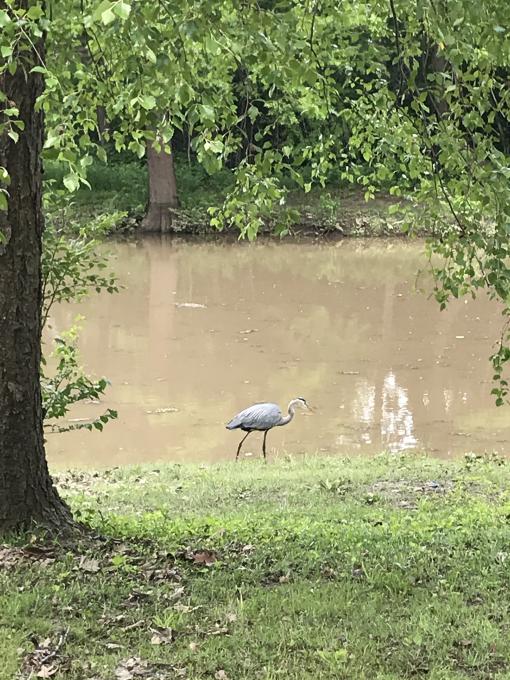
 I saw two Rose-breasted Grosbeaks at my feeder in Seneca, SC, near Lake Keowee. I have never seen them here before. Usually the feeder is overrun with cardinals, house finches, black-capped chickadees, red-headed woodpeckers, tufted titmice and the occasional cowbird.
I saw two Rose-breasted Grosbeaks at my feeder in Seneca, SC, near Lake Keowee. I have never seen them here before. Usually the feeder is overrun with cardinals, house finches, black-capped chickadees, red-headed woodpeckers, tufted titmice and the occasional cowbird. 
